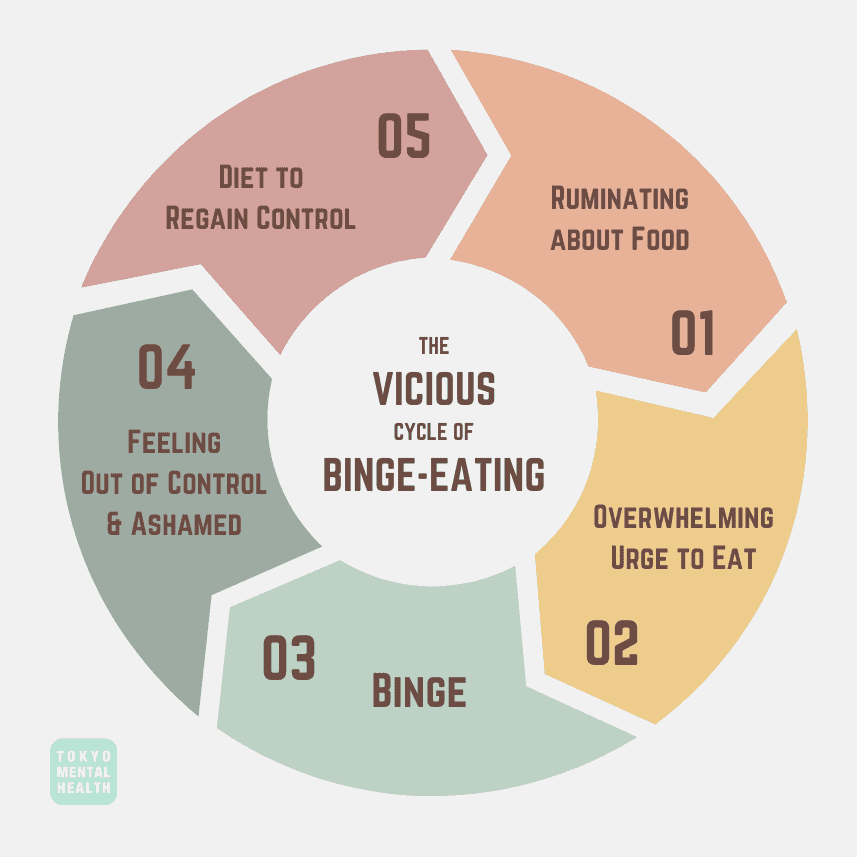The Cycle of: Binge Eating
Today, I'd like to briefly touch on the topic of binge eating and the cycle that perpetuates it. I should note that this description is an oversimplication, as disordered eating is a complex topic with many facets of understanding required for treatment. But my hope in sharing is that it might provide some insights into how moderation and consistency can be important in maintaining a healthy relationship with food.
Let's start with an example. Say an individual with low body image opts to skip lunch in an attempt to lose weight. That person would naturally be hungry and more likely to think about food for the rest of the day. As the hunger and thoughts about food increase, the urge to eat grows to overwhelming levels, leading to the person binging a large box of donuts that they picked up from a drive-thru on their way home from work. After completing the donuts, the person may feel out of control and ashamed for their actions, likely contributing to further negative thoughts about themselves and their bodies. In response, they resolve to again start a strict diet to "make up for the donuts," manage their weight and reduce their shame. Thus, the binge-restrict cycle starts over.

(Image Source: https://www.tokyomentalhealth.com/what-is-binge-eating-disorder/binge-eating-vicious-cycle/ )
As you can tell from this example, restricting food can ultimately lead to binging food later on. Overall, the person's approach to food leaves little room for intentionality with regards to nutrition or health, nor does it allow for any natural enjoyment of eating or listening to hunger cues. The person also attributes their binging to a lack of willpower, feels shame and blames themselves for their binging, when in reality it
was their body's natural need for food that prompted it to seek some
quick calories in the form of carbs and sugar.
In order to avoid or step out of this cycle, a different approach needs to be taken. An important component for anyone trapped within this cycle is to access therapy, so they can address their feelings of shame and harsh self-criticisms that may be at play throughout this cycle. Many individuals also eat food as a form of comfort or to manage painful feelings, which also can be addressed in therapy.
But along with therapy, we can also take a behavioural approach towards this cycle. Eating healthy food at regular intervals, including snacks and meals, allows the body to get the nutrients and calories it needs to sustainably get through the day. It reduces the high urgency for food by the day's end, thus reducing the likelihood of binging.
Besides this being a substantially more healthy approach for the body,
it also provides the calories that the mind needs to be able to think
clearly through decisions rather than acting on impulse. Going back to the example I described, by incorporating in a healthy salad for lunch and some nuts and fruit for snacks, the person's body will not have that strong sense of urgency to eat by the day's end. The person may still stop at a drive-thru for a treat after work, but they make the choice with intention and feel content with one donut rather than a box. If the regular intake of calories helps them think more clearly, perhaps that self-critical voice that evokes low body image may be a little quieter after the donut as well.
As I'd said, this is only a small part of larger treatment protocols that address disordered eating. I hope this overview can help provide some insight and act as a reminder for all of us to think of our food as the fuel our bodies need.
If you believe you experience a form of disordered eating, I would strongly encourage you to speak with a therapist or other medical professionals for treatment.